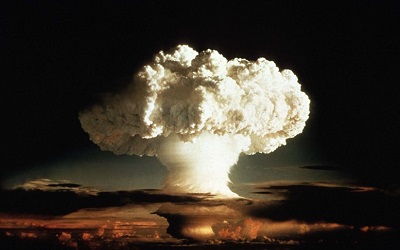January 8, 2018 – Before I begin I warn you that this is a rant on my birthday.
A friend of mine sent me a link on the weekend that is one of the most disturbing I have received in the nine years that I have been writing and posting to this blog site.
It was a formal invitation to a grand rounds session whose focus was on planning and preparing for a nuclear war. In the normal medical parlance, grand rounds refer to a time when doctors and staff regularly get together to study in-patient cases. These grand rounds are far different.
Scheduled for January 16th at 1:00 p.m. Eastern Standard Time, it is open to any U.S. citizen who submits a request to be present as long as they have a U.S. passport or state-issued photo ID. For non-Americans, it’s too late to be there in person because requests needed to be submitted 20 days prior to the event. E-mailed questions, however, can be sent before or during the session. Live web streaming of the event will be available as well. If you are not familiar with the CDC, the acronym by which this agency is known, it is part of the U.S. Department of Health & Human Services of the federal government.
Presentation subject matter includes:
- Preparing for the Unthinkable
- Using Data and Decision Aids to Drive Response Efforts
- Public Health Resources to Meet Critical Components of Preparedness
- Roadmap to Radiation Preparedness
In the general comments about the upcoming event, the CDC site states:
“While a nuclear detonation is unlikely, it would have devastating results and there would be limited time to take critical protection steps. Despite the fear surrounding such an event, planning and preparation can lessen deaths and illness. For instance, most people don’t realize that sheltering in place for at least 24 hours is crucial to saving lives and reducing exposure to radiation.”
Back in 1962, I was in junior high school. As the Cuban Missile Crisis unfolded, our school conducted emergency drills. We were told, in the event of forewarning of a nuclear strike, we should immediately leave our classrooms and go to the inner hallways of the school. We would then get down on hands and knees, place our hands protectively over our heads, and stay close to the walls by our lockers. I remember my parents having discussions with neighbours, friends, and other family about building a fallout shelter. I remember being in our basement and wondering where to hide to survive a thermonuclear attack.
John Kennedy and Nikita Khrushchev were the lead actors in the drama of those October 1962 days when the world held its breath. Fortunately, Kennedy and Khrushchev recognized that insanity of launching of a planet-destroying war.
But today we are not dealing with a Kennedy or a Khrushchev. We have Donald Trump and Kim Jong Un instead.
The intelligence gap between these duos is as wide as the Grand Canyon itself.
The U.S. President trades boorish barbs with North Korea’s leader, comparing the size and capability of each’s nuclear buttons.
The President has talked about a U.S. strike against the rocket and nuclear programs of North Korea as if these could be accomplished surgically with no collateral damage to speak of.
Well maybe a little collateral damage: millions dead in the two Koreas, millions more in neighbouring Japan, and maybe a couple of American cities wiped out before the missile strikes end. Then the post-apocalyptic deaths will follow from the clouds of nuclear fallout that rain down upon areas of the planet far removed from the conflict zones. States Jeffrey Lewis, Director of the East Asian Non-Proliferation Program at the Middlebury Institute of International Studies, located in Monterey, California, the deadly effects would be “so horrible that people don’t really ever want to deal with what it would really look like … There would be survivors for days trying to make their way out of the rubble and back home, dying of radiation poisoning.”
One cannot look at the present confrontation without remembering the Cuban Missile Crisis. In 1962 the U.S. came face-to-face with the U.S.S.R’s nuclear-strike force being deployed in neighbouring Cuba. Missiles launched from there would take only a few minutes to reach U.S. targets.
Today, both the U.S. and North Korea are in the same type of standoff with nuclear bombs atop missiles that could reach each other’s countries within 40 minutes. Negating any North Korean rocket threat with a supposedly effective U.S. missile-defense shield in place it is highly unlikely that every bomb meant to kill South Koreans, Japanese and Americans can be destroyed before hitting some of their targets. That’s without considering nuclear missiles on both sides that go astray and land on non-combatants killing millions of them. Further speculation leads us to worry whether China or Russia feel their interests are at stake in the U.S.-Korean confrontation. Could this escalate beyond the primary combatants? Will there be a place to hide anywhere on the planet should that happen?
So why is the CDC holding a session that further fans the fear? States Kathy Harben, CDC spokesperson, “CDC provides for the common defense of the country against all health threats.” That health threat comes after the thermonuclear explosions occur. So it is good to know that preparing for the post-apocalypse is well in hand. What I would prefer is CDC prevent all of this by declaring the President and his the leader of North Korea to be equally insane and get authorities with muscle from both countries to lock them up. That would be a defense by both countries against a common health threat.








